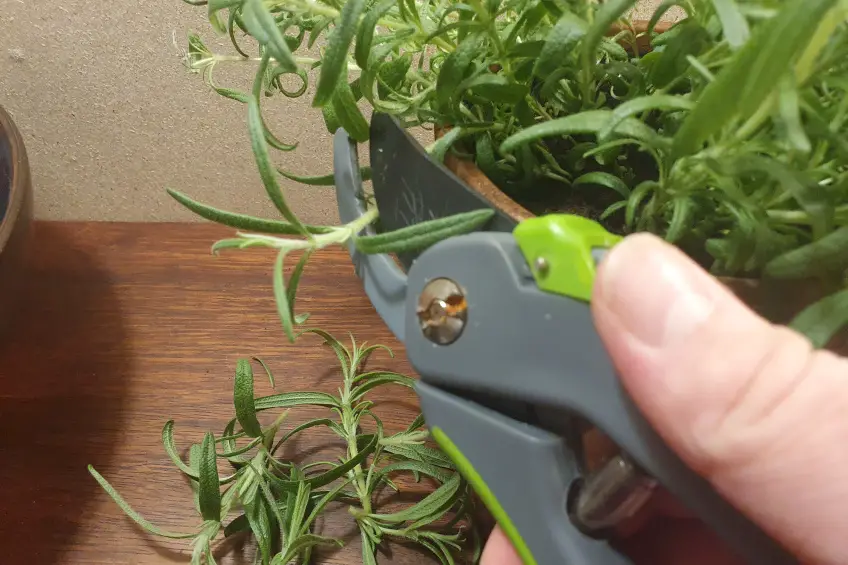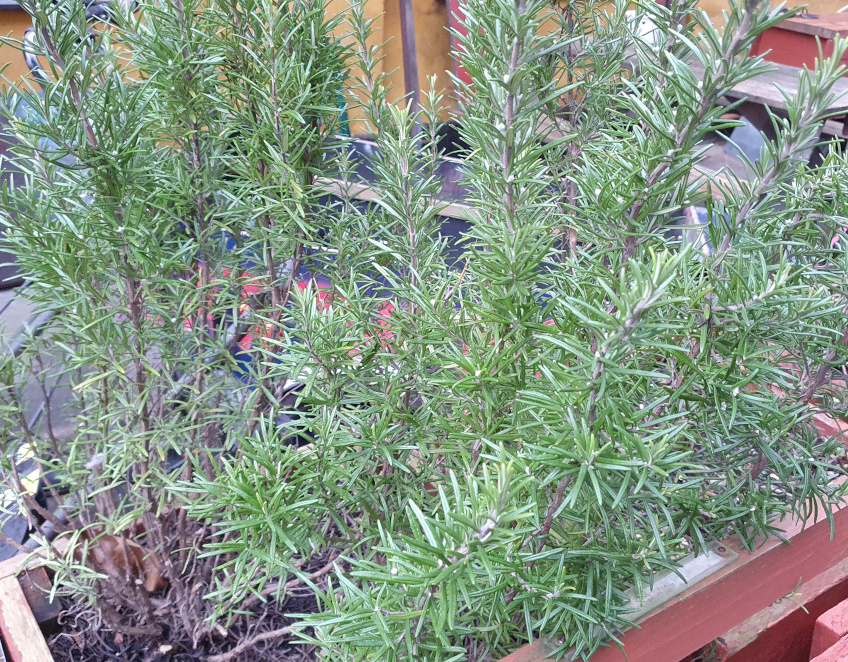It is unnecessary to prune rosemary for it to grow and thrive, but there are several reasons why it is actually a really good idea to do it anyway.
Pruning rosemary plants makes them produce branches and leaves faster. It also makes them denser and bushier and is an excellent way to control the shape and size of the plants. Rosemary can thrive without ever being pruned, although it is less productive and the branches will get hard and woody faster.
Before writing this post, I was not sure if I should prune my rosemary plants or just leave them as they are, so I called one of my favorite garden centers and spoke to a really helpful gardener who told me everything I needed to know.
I have written this post to share what I learned including what happens if you don’t prune it or if you prune it too much, and the easiest way to do it.

3 Reasons Why You Should Prune Your Rosemary Plants
Rosemary is one of those plants that can grow and produce branches and leaves for many years without ever being pruned. In fact, rosemary plants can survive for up to 20 years under the right conditions (more on that here).
It turns out, however, that there are several excellent reasons to prune rosemary plants.
I have several rosemary plants myself, and before writing this post, I didn’t know if I should prune them or not, and I couldn’t really find a satisfying answer online (which is why I decided to write this post). So I did what I often do when I have these types of questions. I called a local garden center where they always have some skilled and experienced gardeners ready to help and answer questions.
The gardener from the garden center I spoke to gave me three good reasons to prune rosemary plants and also taught me the best way to do it and what happens if you do it too much or not at all.
Here are the three primary reasons why it is a good idea to prune rosemary.
1. Rosemary plants produce more if you prune them
Most herbs, including rosemary, respond to being pruned or cut by growing two new branches where you cut it, essentially doubling its growth.
This is my favorite reason why it is a good idea to prune rosemary once in a while. Here is what Camilla, the gardener I spoke to said about it:
For higher production, it is best to cut rosemary periodically, even if you don’t need any at that specific time. Cut a few branches every week or so, whether you need it or not, and make sure to cut evenly from all over the plant and do not cut the newest, freshest shoots.
I usually just cut whatever I need from my rosemary plants whenever I need it, and it turns out, this is one of the best ways to prune the plants as long as you do it consistently and evenly all over the plant.
If you cut more than you need, you can take the leftover cuttings and grow them as new plants to increase the overall production even more. I have a guide for that here.
2. Pruning makes rosemary plants denser and bushier
As mentioned above, cutting a rosemary branch will make it split in two, which essentially doubles its production.
An effect of cutting back rosemary plants is that two new shoots will begin to grow where the branch was cut. This makes the plant appear much bushier and denser, which can be aesthetically pleasing to look at, but also makes the plant produce branches and leaves much faster.
Whether or not you think bushier rosemary plants look good is, of course, subjective, but the fact that it produces more leaves while taking up the same amount of space is not. That is just a neat bonus.
If you’re interested in more tips on how to grow dense and bushy rosemary plants, you can take a look at this post.
3. Pruning rosemary plants is a good way to control the shape and size
Sometimes you may want to reduce the size or change the shape of your rosemary plant, so you may want to give them a heavier pruning than just picking a few branches every now and then, so I asked Camilla (the gardener I spoke to) about this.
You can easily give rosemary plants a heavy pruning if you want to reduce their size or change their shape, but do not cut it back too much. Make sure there are several green leaves left on all the branches you cut, and as a general rule, you should not cut more than about half of a branch at the same time.
Below, I describe what happens if you don’t prune rosemary at all and after that, what happens if you prune it too much and at the end, I share what the gardener I talked to for this post said is the easiest way to prune rosemary plants.
Pruning can actually also be an effective way to solve certain problems. If you are having problems with your rosemary plants and aren’t sure what to do, I recommend that you head over to the article on this link where I cover a lot of common problems and explain how to solve them.
What Happens if You Dont Prune Rosemary?

Rosemary is a natural Mediterranean herb, and in nature, it does not get pruned as consistently as you will be able to when growing it at home.
Rosemary plants that appear in nature grow and thrive just fine without ever being pruned (other than if some animals come and bite off fresh shoots or some branches break off).
If you do not prune your rosemary plants, they will continue to grow and get taller, but the branches will also harden and turn woody faster. Once the branches turn woody, they become stronger and can resist colder temperatures, but they are also not well-suited for cooking (although the leaves are still fine).
Camilla, the gardener I spoke to on the phone, said that she had a rosemary plant at home that was more than 3 feet (about a meter) tall since she never pruned it and that they can get even taller than that, so they can grow just fine without being pruned.
What Happens if You Prune Rosemary Too Much?
Some herbs don’t respond well to being pruned too much. It can inhibit their growth and even damage them so severely that it takes months to grow back if they ever do. So a good rule of thumb is to never cut back more than about a third at once.
Rosemary is different, however, and according to Camilla, the gardener I spoke to before writing this post, it is actually hard to prune rosemary too much.
As a general rule, rosemary branches should not be cut back more than about halfway, but as long as there are green leaves on a branch, it will most likely grow back as two fresh new shoots within a short amount of time.
So you can basically cut it back as much as you want, as long as there are green leaves left on the branches you cut. This makes rosemary and other similar plants (such as lavender) excellent for shaping and growing as bushes of whatever size and shapes you prefer.
Below, I explain the easiest way to prune rosemary and the best time to give your rosemary a heavy pruning since doing it at the wrong time can damage the plant.
Easiest Way to Prune Rosemary (And Best Time)
When I called and spoke to the gardener from the garden center, she taught me that the best and most straightforward way to prune rosemary is to just take whatever you need, whenever you need it. Here is what she said:
If you use rosemary in the kitchen on a somewhat frequent basis, the best way to prune it is to simply cut off whatever you need whenever you need it, and to make sure you cut evenly from all over the plant.
If you need to give your rosemary plant a heavier pruning to reduce the size or change the shape, you should do it during the growing season when there is absolutely no risk of frost for at least 6 weeks. Cut back all the branches about halfway, but make sure there are leaves left on all the branches you cut, as they will likely not grow back otherwise.
Camilla, gardener.
If you decide to give your rosemary plant a big pruning to cut back the size or change the shape of it, you might as well save the branches and leaves you removed and dry them. Depending on the size of your rosemary plant, a heavy pruning can provide you with enough leaves for several months.
When you prune rosemary (or any other plant for that matter), it is always best to use clean and sharp pruning shears to avoid damaging the plant and reducing the risk of infections.
